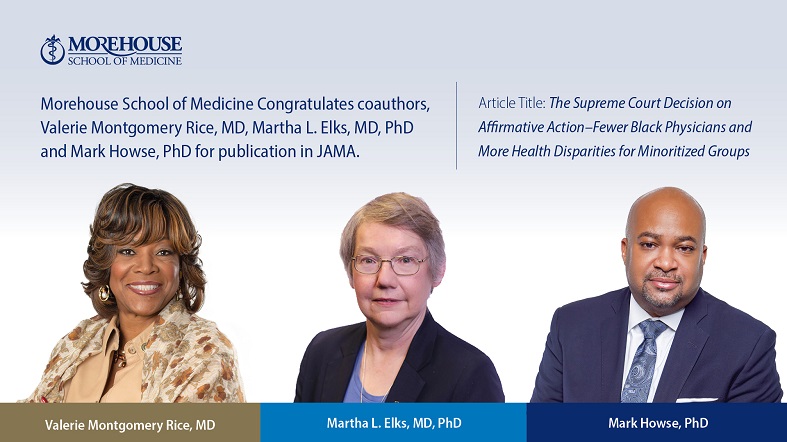The Supreme Court Decision on Affirmative Action — Fewer Black Physicians and More Health Disparities for Minoritized Groups
By Valerie Montgomery Rice, MD; Martha L. Elks, MD, PhD; and Mark Howse, PhD
Published in the Journal of the American Medical Association, August 25, 2023
The US Supreme Court’s June 29, 2023, ruling on Students for Fair Admissions, Inc v University of North Carolina and the paired case against Harvard overturned nearly 50 years of the use of affirmative action in higher education to address the inequities of systematic racism in the US. The decision eliminates the consideration of race and ethnicity for admissions to colleges and universities and has the potential to significantly reduce the number of Black physicians and increase health inequity in underserved communities, some of which are health care deserts. The ruling by the Court is grounded in its opinion that the US Constitution is color-blind and that race- and ethnicity-based admissions programs are unconstitutional. The Court ignores hundreds of years of slavery, segregation, and other forms of discrimination that affected Black people and other minority groups, suggesting that students should be admitted to colleges based on their own merit, as measured through numeric parameters, such as grade point average and standardized test scores.
The decision reflects a woeful misunderstanding of the role of numeric parameters in selecting candidates for matriculation into medical school or other institutions of higher learning. The decision implicitly supports a dominant role for these parameters over skills, life experiences, and distance traveled and denies the fact that representation matters. The purpose of affirmative action, well documented in the case for its role in women’s advancement in Valian’s Why So Slow? The Advancement of Women,1 is to counter the inevitable in-group bias of decision makers. Without intentional counterbalance, inequities of power are inevitable.
Affirmative action contributed to important aspects of improving the health and well-being of US residents through the diversification of the health care workforce. Although such policies helped achieve gender equality in medical school enrollment, the Court’s decision takes away an important tool for institutions of higher education seeking to achieve racial equity and increase the number of Black medical students. Health care practitioners from Black and other minority communities that continue to experience unconscionably disproportionate morbidity and mortality have been documented to have a key role in efforts to achieve optimal health for all US residents.2 Although we and others have launched a number of major research efforts for diseases such as diabetes, heart disease, and maternal mortality that impact minority communities, racial and ethnic minority groups continue to have these illnesses in higher percentages than White individuals.3
There is a compelling interest for the US to support a diverse health care workforce. There is ample and redundant documentation of poor outcomes for patients from communities underrepresented in the health care workforce. Multiple research studies have shown that patients have improved outcomes when they are treated by people of a similar background or race or ethnicity.4 For example, research shows that Black infants treated by Black physicians have better health outcomes. In addition, the Association of American Medical Colleges (AAMC) has reported that students, no matter their race or ethnicity, who train in diverse settings are better able to treat people from all backgrounds.5
Although the adverse effects of the Court’s decision affect multiple aspects of higher learning, in the case of medical education, the decision goes beyond college admissions for Black people and other minority groups to the very core of the health of the entire country. Health statistics for the US lag well behind those of other industrialized nations,6 with the worst health care outcomes of any high-income nation in the world. Life expectancy in the US in 2020 was 77 years, 3 years lower than that of a peer country. In the same year, infant mortality in the US was 5.4 deaths per 1000 live births, the worst performance of any country included in the study. We cannot achieve optimal health for our nation without achieving health equity for the Black community. Current inequities will not improve if we restrict the opportunity to obtain a medical degree to fewer individuals based solely on criteria such as grade point average and Medical College Admission Test (MCAT) score. Although these parameters are important, they are not objective predictors of success for a physician, nor do they predict how well a student will do in medical school or how good a physician he or she will become. The AAMC data suggest that although the MCAT score was moderately predictive of the standardized test score on the US Medical Licensing Examination Step 1 (now pass-fail), most students at all score ranges passed Step 1 on the first attempt. Many students with scores well below the national mean for matriculants can succeed in medical school; MCAT score was not a linear predictor of other aspects of success.7-9
Fortunately, there are approaches that are already being used and can continue to be used to ensure that US medical schools are able to recruit and train a cadre of individuals who will diversify the health care workforce and play a major role in creating and advancing health equity.
Morehouse School of Medicine was founded nearly 50 years ago with the dual mission to help increase the number of Black physicians in the US and improve health equity in underserved urban and rural communities. Throughout the decades, the school has remained true to this mission, graduating more than 1700 physicians; on average, 70% work in underserved US communities. Morehouse School of Medicine students come to the school with an inherent love of their communities and a desire to help improve health care in those communities. That is why so many of our students return to their communities and are able to provide the culturally competent care that is required to help turn the tide of health disparities faced by many Black people and individuals from other minority groups.
In 2017, Morehouse School of Medicine reached a significant milestone, enrolling 100 students in its medical education program. Despite this remarkable progress, the fact remains that although Black people make up 13% of the US population, they represent only 5% of physicians; this percentage has not changed over 50 years. If the country were truly color-blind, then the percentages of Black physicians, lawyers, engineers, and college graduates overall, for example, would be closer to the percentage of Black individuals in the population. The AAMC projects that the US will be facing a shortage of up to 124,000 physicians in 2034.10 We cannot achieve optimal national health without increasing the number of physicians and health care professionals from affected minority communities.
Morehouse School of Medicine uses a holistic admissions process to admit students who are aligned with our mission and considers grade point average and MCAT score as only 2 of 10 admission criteria. We have documented that with our approach, milieu of support, and role models, students whose credentials are judged by many schools as “not ready” show unimpeded progression. Over the past 10 years, more than 95% of the students admitted to Morehouse School of Medicine with a score consistent with an MCAT score below the national mean for matriculants have earned a passing Step 1 score. That translates to nearly 300 students, more than 200 of whom are Black and have become or are on track to become a practicing physician; these individuals would have been denied medical school admissions by traditional criteria.7
The Supreme Court’s decision will make it even more challenging to increase the number of minority physicians and other health care professionals when we are facing acute shortages in the overall US health care workforce. With an inadequate number of physicians, especially in the Black community, health inequity will increase, and our country is likely to fall even farther behind its peers in both the quantity and quality of health care. James Madison, the “founding father of the Constitution,” once said, “The purpose of the Constitution is to restrict the majority’s ability to harm a minority.” In the medical community, it is hard to see how this ruling will not harm minority communities.
References
- Valian V. Why So Slow? The Advancement of Women. MIT Press; 1998.
- Snyder JE, Upton RD, Hassett TC, Lee H, Nouri Z, Dill M. Black representation in the primary care physician workforce and its association with population life expectancy and mortality rates in the US. JAMA Netw Open. 2023;6(4):e236687. doi:10.1001/jamanetworkopen.2023.6687
- Greenwood BN, Hardeman RR, Huang L, Sojourner A. Physician-patient racial concordance and disparities in birthing mortality for newborns. Proc Natl Acad Sci U S A. 2020;117(35):21194-21200. doi:10.1073/pnas.1913405117
- Shen MJ, Peterson EB, Costas-Muñiz R, et al. The effects of race and racial concordance on patient-physician communication: a systematic review of the literature. J Racial Ethn Health Disparities. 2018;5(1):117-140. doi:10.1007/s40615-017-0350-4
- Saha S, Guiton G, Wimmers PF, Wilkerson L. Student body racial and ethnic composition and diversity-related outcomes in US medical schools. JAMA. 2008;300(10):1135-1145. doi:10.1001/jama.300.10.1135
- Gunja MZ, Gumas ED, Williams RD II. US health care from a global perspective, 2022: accelerating spending, worsening outcomes. Commonwealth Fund. Published January 31, 2023. http://www.commonwealthfund.org/publications/issue-briefs/2023/jan/us-health-care-global-perspective-2022
- Elks ML, Herbert-Carter J, Smith M, Klement B, Knight BB, Anachebe NF. Shifting the curve: fostering academic success in a diverse student body. Acad Med. 2018;93(1):66-70. doi:10.1097/ACM.0000000000001783
- Busche K, Elks ML, Hanson JT, et al. The validity of scores from the new MCAT exam in predicting student performance: results from a multisite study. Acad Med. 2020;95(3):387-395. doi:10.1097/ACM.0000000000002942
- Hanson JT, Busche K, Elks ML, et al. The validity of MCAT scores in predicting students’ performance and progress in medical school: results from a multisite study. Acad Med. 2022;97(9):1374-1384. doi:10.1097/ACM.0000000000004754
- IHS Markit Ltd. The Complexities of Physician Supply and Demand: Projections From 2019 to 2034. AAMC; 2021.


